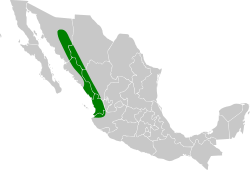Description
The elegant quail grows to a length of about 25 cm (10 in). [2] The male has a distinctive long, straight, golden-buff crest (the female's crest is grey). In other ways the sexes are similar in appearance, being mainly grey with spotting and streaking in black, brown and white, and in the case of the male, in reddish-brown as well. The beak is black, the irises are brown and the legs dark grey to black. This bird can be distinguished from the otherwise similar scaled quail (C. squamata), California quail (C. californica), and Gambel's quail (C. gambelii) by the colour of the male's crest and by the paler spotting on the flanks. [3]
Vocalisations include a "chip-chip" call used by members of a covey to help them remain in contact as they feed on the ground by day, and a "cu-cow" call given on assembly at the roosting site in the evening, and again in the morning before setting off to forage. [3]
This page is based on this
Wikipedia article Text is available under the
CC BY-SA 4.0 license; additional terms may apply.
Images, videos and audio are available under their respective licenses.


